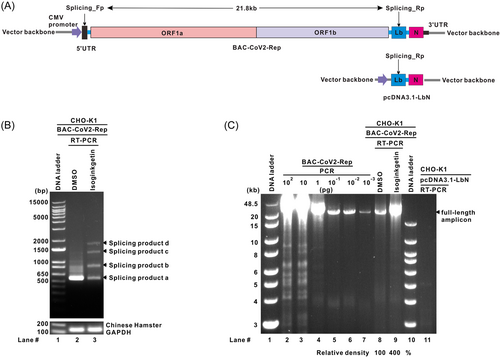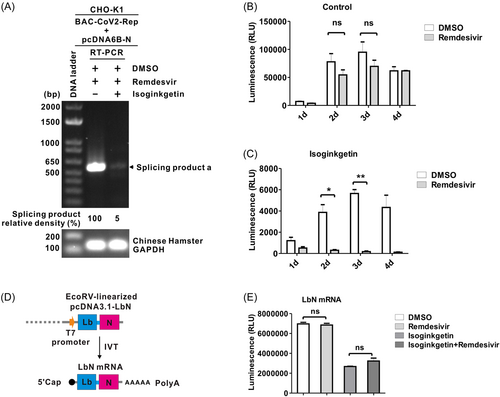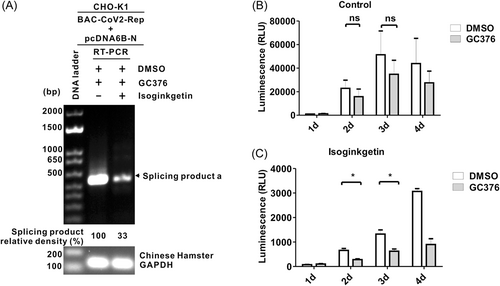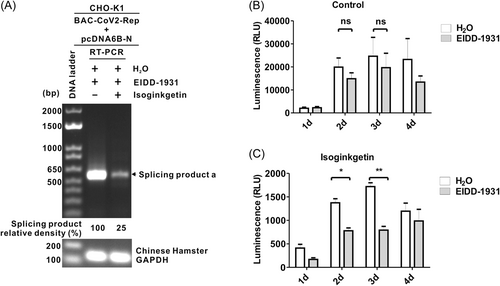Optimization of a DNA-launched SARS-CoV-2 replicon with RNA splicing inhibitor Isoginkgetin
Abstract
We have previously developed a bacterial artificial chromosome (BAC)-vectored SARS-CoV-2 replicon, namely BAC-CoV2-Rep, which, upon transfection into host cells, serves as a transcription template for SARS-CoV-2 replicon mRNA to initiate replicon replication and produce nanoluciferase (Nluc) reporter from the subgenomic viral mRNA. However, an inherent issue of such DNA-launched replicon system is that the nascent full-length replicon transcript undergoes process by host RNA splicing machinery, which reduces replicon replication and generates spliced mRNA species expressing NLuc reporter independent of replicon replication. To mitigate this problem, we employed Isoginkgetin, a universal eukaryotic host splicing inhibitor, to treat cells transfected with BAC-CoV2-Rep. Isoginkgetin effectively increased the level of full-length replicon transcripts while concurrently reducing the level of Nluc signal derived from spliced replicon mRNA, making the Nluc reporter signal more correlated with replicon replication, as evidenced by treatment with known SARS-CoV-2 replication inhibitors including Remdesivir, GC376, and EIDD-1931. Thus, our study emphasizes that host RNA splicing is a confounding factor for DNA-launched SARS-CoV-2 replicon systems, which can be mitigated by Isoginkgetin treatment.
1 INTRODUCTION
Since the beginning of the COVID-19 pandemic, the reverse genetics approach has been widely utilized to generate noninfectious recombinant SARS-CoV-2 replicon systems carrying reporter genes for both basic and antiviral research in BSL-2 laboratory settings.1 Our lab has previously established an in vitro transcription (IVT)-based SARS-CoV-2 RNA replicon (IVT-CoV2-Rep) and a bacterial artificial chromosome (BAC)-vectored DNA-launched replicon (BAC-CoV2-Rep), both of which carry a nanoluciferase (Nluc) gene embedded in the viral subgenomic RNA moiety as a reporter for replicon replication fitness.2 The Nluc reporter signal coming from the directly transfected IVT-CoV2-Rep RNA could be completely blocked by the known SARS-CoV2 replication inhibitors, including Remdesivir, GC376, and EIDD-1931, confirming the correct design of the replicon genome. However, the Nluc signal from the more convenient and robust DNA-launched BAC-CoV2-Rep exhibited a high degree of resistance to the above antiviral drugs. Such phenomenon has also been observed in some other plasmid-vectored SARS-CoV-2 replicons,3-6 indicating the existence of replication-independent reporter signal in the DNA-launched replicon systems. Our continuous study revealed that the alternative RNA splicing occurs on the full-length replicon transcripts derived from the transfected BAC-CoV2-Rep template in nucleus, giving rise to spliced RNA variants that carry Nluc ORF in close proximity to 5′ cap of mRNA for direct expression of Nluc independent of replicon replication.2
In the present study, we applied a general pre-mRNA splicing inhibitor Isoginkgetin during BAC-CoV2-Rep transfection. Isoginkgetin is a biflavonoid compound derived from the leaves of the Ginkgo biloba tree and it can block the spliceosome-mediated splicing process at the prespliceosome/A complex stage.7 The Isoginkgetin treatment significantly decreased the level of Nluc ORF-containing spliced RNA and augmented the full-length replicon transcript. Although the total level of Nluc signal in BAC-CoV2-Rep-transfected cells was decreased upon Isoginkgetin treatment, the SARS-CoV-2 replication inhibitors were able to efficiently suppress the Nluc signal derived from the replicon replication. These results further demonstrated that host alternative splicing contributes to a large portion of BAC-CoV2-Rep-derived Nluc reporter signal in a replicon replication-independent manner, which could be mitigated by employing RNA splicing inhibitor Isoginkgetin. Our study just provides a solution to further optimize the DNA-launched SARS-CoV-2 replicon systems for antiviral research.
2 MATERIALS AND METHODS
2.1 Cell line, plasmids, and compounds
Chinese hamster ovary cell line CHO-K1 was purchased from the American Type Culture Collection (ATCC). Cells were maintained in Dulbecco's Modified Eagle Medium: Nutrient Mixture F-12 (DMEM/F-12) supplemented with 10% fetal bovine serum and 1% penicillin/streptomycin. The SARS-CoV-2 replicon plasmid BAC-CoV2-Rep, plasmid pcDNA3.1-LbN expressing Nluc-blasticidin (Lb) fusion protein, and plasmid pcDNA6B-N expressing C-terminally FLAG-tagged SARS-CoV-2 nucleocapsid (N) protein were described in previous publications.2, 8 SARS-CoV-2 antiviral compounds Remdesivir, GC376 and EIDD-1931 were purchased from SelleckChem. Remdesivir and GC376 were dissolved in DMSO to make 10 mM stocks. EIDD-1931 was dissolved in water to make a 10 mM stock. Isoginkgetin was purchased from Tocris and dissolved in DMSO as 25 mM stock.
2.2 Transfection, compound treatment, and NLuc quantification
The plasmid BAC-CoV2-Rep was transfected into cells using Lipofectamine 3000 (Invitrogen). The EcoRV-linearized plasmid pcDNA3.1-LbN was used as an IVT template for LbN mRNA transcription as previously described,2 followed by cell transfection using Lipofectamine MessengerMAX (Invitrogen) at a 1:2 ratio (μg:μL). On the same day of transfection, the cells were treated with indicated compounds or solvent control for indicated time durations, the treatment was refreshed every other day. At indicated time points, the cells were harvested and subjected to total RNA extraction and RT-PCR assay, or lysed with Nano-Glo NLuc solution (N1120, Promega) and the luminescence signal was detected using a Synergy HTX Microplate Reader (BioTek).
2.3 RT-PCR
Total RNAs were extracted from BAC-CoV2-Rep-transfected cells and digested by RQ1 RNase-Free DNase (Promega). The cDNA template was prepared with 1 μg total RNA by oligo (dT) using SuperScript IV Reverse Transcriptase (Thermo Fisher Scientific). 1 μL of the total 20 μL RT products was subjected to PCR reaction using Terra PCR Direct Polymerase (TAKARA) and the following primer pairs: the BAC-CoV2-Rep spliced RNA forward primer (Splicing_Fp) ATCAGCACATCTAGGTTTCGT and reverse primer (Splicing_Rp) TTCTAGCAGGAGAAGTTCCC; the Chinese hamster GAPDH forward primer (CH_GAPDH_Fp) GCGACTTCAACAGTGACTCCC and reverse primer (CH_GAPDH_Rp) CCACTCTGTTGCTGTAGCCAA. The reaction mixes were prepared according to the Terra polymerase manual. The thermal cycler was set as 98°C 2 min. 35 cycles of 98°C 10 s, 60°C 15 s, and 68°C 2 min or 15 min. The RT-PCR products were loaded in an agarose gel (1.2% or 0.8%) and the visualized DNA bands were purified and cloned into the pSC-A-amp/kan vector (Agilent) for Sanger sequencing.
2.4 Statistical analysis
Data are provided as the mean ± standard deviation (SD). Calculations and graphs were generated using GraphPad Prism 9.0. Student's t test was used to determine the statistical significance. A p value less than 0.05 (p < 0.05) was considered statistically significant.
3 RESULTS
3.1 Isoginkgetin treatment inhibits BAC-CoV2-Rep mRNA splicing
A pair of primers (Splicing_Fp and Splicing_Rp) targeting the 5′ UTR and Nluc-blasticidin (Lb) fusion ORF on the replicon genome, respectively, were designed to detect the potential spliced RNA species that could directly translate Lb2 (Figure 1A). This primer pair can amplify a 21.8-kb product directly from the BAC-CoV2-Rep plasmid and the cDNA template of full-length replicon RNA. PCR from plasmid pcDNA3.1-LbN containing only the Splicing Rp primer targeting region was set as a negative control. CHO-K1 cells were transfected with BAC-CoV2-Rep and treated with pre-mRNA splicing inhibitor Isoginkgetin or solvent DMSO control for 2 days, followed by total RNA extraction and RT-PCR. As shown in Figure 1B, the control group (lane 2) exhibited a predominant ~550 bp product (Splicing product a) with 2 min PCR extension time, and cloning sequencing revealed an intact NLuc ORF close to the mRNA 5′ end, which was consistent with our published data.2 However, the Isoginkgetin-treated group had a significantly decreased level (~25% of control) of the ~550 bp PCR product. There were also three additional splicing products (b–d) that emerged in the Isoginkgetin treated group. The cloning sequencing result suggested these were nonspecific amplifications of Chinese hamster ribosomal 18S (Splicing product b and c) and 28S RNA (Splicing product d). These results indicated that the host alternative splicing was inhibited by the Isoginkgetin treatment and therefore reduced the level of spliced RNA containing Lb ORF. To further confirm this, the same RT samples from Figure 1B were subjected to PCR with a longer extension time (15 min) for amplifying the full-length replicon mRNA. The 10-fold serially diluted BAC-CoV2-Rep plasmid DNA served as positive control (lanes 2-7). As shown in Figure 1C, the level of full-length replicon mRNA RT-PCR product was significantly higher in the Isoginkgetin-treated group compared to the control group (lane 9 vs. 8), demonstrating that the inhibition of host pre-mRNA splicing indeed increased the copies of full-length replicon mRNA.

3.2 Isoginkgetin treatment highlights the Nluc reporter signal derived from replicon replication
Remdesivir, GC376, and EIDD-1931 are the known compounds that inhibit SARS-CoV2 genome replication through acting as viral RdRp inhibitor, 3CLpro inhibitor, and lethal viral mutagen, respectively.9 Our previous assessment of their antiviral activities in BAC-CoV2-Rep system demonstrated that these compounds exhibited potent inhibition of replicon replication as evidenced by northern blot of replicon RNA, but only slightly reduced the Nluc reporter signal.2 Such discrepancy intrigued us to discover the splicing-derived Nluc signal independent of replicon replication (Figure 1), which is specific to DNA-launched SARS-CoV-2 replicons but absent in viral infection and IVT-based RNA replicon systems.
Here, we employed Isoginkgetin to treat the BAC-CoV2-Rep-transfected cells and examined whether the Nluc reporter signal could be readily inhibited by antiviral drugs. Plasmid pcDNA6B-N was cotransfected to enhance the replicon as we described previously.2 The splicing product of ~550 bp served as an indicator of replicon mRNA splicing event. When the splicing product a is reduced upon Isoginkgetin treatment, it signifies that the splicing-derived Nluc signal contributes less to the total Nluc signal. Under the combination treatment by Isoginkgetin and Remdesivir, the splicing product a was dramatically decreased by 95% compared to Remdesvir monotreatment (Figure 2A); the time course Nluc measurement demonstrated that the signal peaked at Days 2 and 3 posttransfection (Figure 2B), which was consistent with previous observations2; although the total Nluc signal strength was also proportionally reduced by Isoginkgetin treatment (Figure 2B,C, comparing DMSO control to Isoginkgetin alone) presumably due to the decrease of splicing-derived Nluc expression, the remaining Nluc signal in the Isoginkgetin-treated group was significantly reduced by co-treatment with Remdesivir (Figure 2C) compared to what Remdesivir achieved without the assistance of Isoginkgetin (Figure 2B).

To assess whether there is any potential effect of Isoginkgetin on LbN signal independent of replicon mRNA splicing, we used pcDNA3.1-LbN as a template to in vitro transcribe the LbN mRNA (Figure 2D); this mRNA was then transfected into CHO-K1 cells and treated with Remdesivir and Isoginkgetin, either individually or in combination. As shown in Figure 2E, Remdesivir treatment failed to reduce the Nluc signal in the absence or presence of Isoginkgetin, confirming that the reduction of Nluc signal in Figure 2B,C following Remdesivir treatment stemmed from inhibition of replicon replication. It is noteworthy that the Isoginkgetin treatment of LbN mRNA transfection also resulted in a decrease of Nluc signal (~3-fold), which is likely due to an indirect impact from inhibition of cellular mRNA splicing.7 Nonetheless, the reduction of Nluc signal by Isoginkgetin treatment was more pronounced in the BAC-CoV2-Rep system (~20-fold) (Figure 2B,C, comparing Day 2 with and without Isoginkgetin treatment), indicating that the primary cause of Nluc signal reduction from Isoginkgetin treatment was direct inhibition of replicon mRNA alternative splicing.
Moreover, the antiviral efficacy against BAC-CoV2-Rep demonstrated by Isoginkgetin coadministration was similarly observed with treatments involving GC376 and EIDD-1931 (Figures 3 and 4), albeit with less inhibitory effect compared to Remdesivir. Collectively, the above findings suggest that Isoginkgetin, a general pre-mRNA splicing inhibitor, reduces the Nluc signal derived from alternative splicing of BAC-CoV2-Rep RNA and highlights the desired Nluc signal arising from replicon replication, enabling the genuine inhibition of Nluc reporter signal by SARS-CoV-2 replication inhibitors.


4 DISCUSSION
In comparison to the IVT-based SARS-CoV-2 replicon, the DNA-launched replicon systems, including the BAC-vectored replicon, are advantageous in terms of convenience and robustness. The replicon cDNA, under the control of a strong eukaryotic promoter, can be directly transfected into cells without the need of in vitro transcription and continuously supports replicon RNA transcription to maintain replicon replication in the course of transient transfection.1, 2 However, when a reporter gene is engineered into the 3′ portion of replicon genome to monitor replicon replication, the nascent full-length replicon RNA transcript undergoes mammalian RNA splicing to produce replication-independent reporter signals, and the reporter signals are variable among different host cell types and from experiment to experiment2-4, 10 (Figure 1). In this study, by using the general host alternative splicing inhibitor Isoginkgetin, we further demonstrated that the host RNA splicing mechanism is responsible for the replicon replication-independent reporter signal, and inhibition of RNA splicing by Isoginkgetin could highlight the antiviral effect of SARS-CoV-2 replication inhibitors when using replicon reporter as a readout (Figures 2-4). Thus, Isoginkgetin can be included in the culture of DNA-launched SARS-CoV-2 replicon systems for antiviral assessment and/or screening of viral replication inhibitors. However, the host-targeting nature of Isoginkgetin is a downside for experiments requiring long-term treatment, as we have found that the prolonged treatment (>4 days) with Isoginkgetin exhibited cytotoxicity (data not shown). Moreover, even with short-term treatment, Isoginkgetin treatment resulted in the reduction of Nluc signal in LbN mRNA transfection (Figure 2D,E), indicating an indirect inhibition of reporter signal by Isoginkgetin from targeting host mRNA splicing. In this regard, Isoginkgetin should be primarily employed to assist the study of direct-acting antivirals in DNA-launched SARS-CoV-2 replicon systems. Alternatively, future studies could explore the possibility of mutating the potential RNA splicing sites of the BAC-CoV2-Rep sequence without adversely affecting replicon expression and replication.
On the other hand, since the BAC-CoV2-Rep only supports a transient replicon replication and Isoginkgetin treatment can increase the level of full-length replicon RNA, we thus hypothesized that Isoginkgetin may be able to promote the establishment of a stable replicon system. To this end, we treated the BAC-CoV2-Rep-transfected CHO-K1 cells for 3 days and continued to culture the cells under blasticidin selection. However, several attempts failed to yield stable replicon cells, even in the context of pcDNA6B-N cotransfection or in the CHO-K1-N cell line stably expressing SARS-CoV-2 N protein, which has been reported to facilitate viral replication.11 It is worth noting that most, if not all, reported SARS-CoV-2 replicons only support a transient replicon replication in transfected cells, including those only with spike (S) gene being detected,10, 12 indicating that the S gene and perhaps other structural and accessory genes contain important cis-element (s) for a sustained replication of SARS-CoV-2 genome. Nonetheless, with the assistance of Isoginkgetin and other optimizations, the BAC-CoV2-Rep holds the promise for further development into a better research tool for studying SARS-CoV-2 replication and antivirals.
AUTHOR CONTRIBUTIONS
Conceptualization, plan, and management: Haitao Guo. Experimental design: Hu Zhang and Haitao Guo. Execution of experiments, acquisition, analysis, or interpretation of data: Hu Zhang and Haitao Guo. Drafting and revision of the manuscript: Hu Zhang and Haitao Guo. Manuscript editing and approval: Hu Zhang and Haitao Guo.
ACKNOWLEDGMENTS
The authors thank Drs Pei-Hui Wang (Shandong University) and Yuan Liu (Cornell University) for providing plasmid pcDNA6B-N. This study was supported by UPMC Hillman Cancer Center Startup Fund (to HG).
CONFLICT OF INTEREST STATEMENT
The authors declare no conflict of interest.
Open Research
DATA AVAILABILITY STATEMENT
The data that support the findings of this study are available from the corresponding author upon reasonable request.




